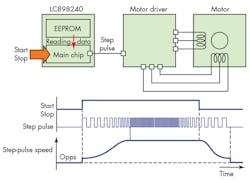This file type includes high-resolution graphics and schematics when applicable.
Millions of small electrical devices with built-in motor-driven mechanisms, used daily around the world, rely on stepper motors for low-cost motion that can be controlled easily without a complex microprocessor-based driver. These include multifunction office printers/scanners, cash machines, point-of-sale terminals, sewing machines, and numerous industrial applications.
In many cases, the stepper motor is the best fit for the varied requirements that must be met, but it’s not a perfect or ideal solution. Audible noise from the motors can be distracting, particularly in industrial scenarios where large numbers of motors may be operated simultaneously in the same area. In addition, the driver consumes power even in low rotation speed, and that generally contradicts eco-design objectives and can compromise the battery life of handheld applications.
Moreover, low overall energy efficiency causes high heat dissipation, which sometimes requires a cooling fan to be designed into the product. This adds cost, complexity and power demand, and also reduces system reliability.
Alternative motor types, such as brushless dc (BLDC) electric motors, can overcome these known disadvantages of stepper motors. They are highly efficient with optimized motor control, along with smoother and quieter control due to step-free movement, thereby consuming less power and generating less heat.
On the other hand, overall system cost tends to be higher when using a BLDC. This is partly due to the fact that controlling the BLDC requires more complex algorithms that must be run in a microcontroller. Moreover, changing from a stepper motor to BLDC requires a significant redesign of the mechanical subsystems, in addition to developing the control software. These demands can significantly increase project costs and time to market. Finally, when the design is completed, the team must take time to collect long-term reliability data.
A New Way
A better solution would be if the stepper-motor drive could be made to turn as efficiently as a BLDC, and with low audible noise, without requiring substantial redesign or expensive control components. This way, designers could deliver next-generation devices that are quieter, greener, free of cooling fans, and more reliable. By improving stepper-motor controllers in two key areas—adjustment of the motor-driving current and the method of step-pulse generation—existing mechanisms can deliver that desired BLDC-like performance.
Addressing this issue, ON Semiconductor developed the LC898240 current controller, which provides a means of automatically optimizing the driver’s constant-current setting as the motor load changes. This allows the stepper motor to drive efficiently, similar to the motion of a BLDC, and minimizes audible noise and wasted energy. The motor load is assessed by monitoring the back-electromotive-force (BEMF) waveforms in a motor winding (Fig. 1).
The LC898240 is connected as a companion device to a conventional motor driver, to extend stepper-motor control functionality. In addition to enabling high-efficiency motor drive through load-related adjustment of the winding current, it’s also able to generate motor step pulses independently, thereby enabling microprocessor-less operation. This feature is implemented with an on-chip EEPROM used to store nine different 440-step pulse profiles that are user-selectable to give a choice of pulse sequences suitable for a variety of applications.
The IC can also interpret control signal inputs from a microprocessor, therefore acting as an interface converter in a microprocessor-controlled drive. Figure 2 shows how the profile stored in the LC898240 EEPROM is applied to the motor-drive IC.
Companion Chip or Single-Chip
The LC898240 can be used with existing motor-drive ICs of various ratings. Such flexibility brings the advantages of BLDC-like motion to stepper-motor drives with various motor-drive current based on the motor-drive IC’s capabilities. The functions of the companion IC have also been integrated in a single-chip driver IC, the LV8702V, which is able to adapt to motor load via BEMF waveform monitoring internally and operating just as the LC898240. Figure 3 illustrates the opportunity for a single-chip high-efficiency stepper-motor driver.
The performance of the LV8702V’s high-efficiency ON mode has been compared with the high-efficiency OFF mode of a conventional drive method. It demonstrates that high-efficiency-mode drive can reduce power by up to 80% (Fig. 4).
Figure 5 shows thermal images of the motor and LV8702V in each mode. High-efficiency-mode drive, which is a current-controlled operation, reduces the surface temperature of the driver and motor by up to 46°C and 28°C, respectively. This also highlights the potential for significantly improved system reliability.
Conclusion
Stepper motors are an attractive solution for driving mechanisms in cost-sensitive applications, such as office machines, transaction equipment and some types of industrial machinery. To satisfy market demands for better performance and usability, at an economical price, two key aspects of motor-control strategy were enhanced, resulting in high energy efficiency, reduced heat generation, and quieter and smoother operation.
This can be achieved with the addition of current control and lookup-based pulse generation, which can be implemented discretely or integrated with the driver circuitry. It offers the flexibility to support microprocessor-controlled or microprocessor-free operation for optimum system performance, cost, and solution size.
About the Author
Koji Yamada
Regional Marketing Manager
Koji Yamada is a Regional Marketing Manager at ON Semiconductor. He specializes in motor-controller, battery-management, DSP and power-discrete technologies. Koji has more than 10 years’ experience in technical and product marketing, along with 20 years of experience in circuit design and R&D in consumer and industrial applications.







